Courtesy of San Benito High School:
For the second year in a row, San Benito High School has been ranked as a “Best High School” by U.S. News & World Report. SBHS is in the top quarter (ranked 626th out of 2,605) of high schools in California and nationwide (ranked 4,204th out of 17,792 schools).
The latest recognition continues to showcase the academic and student focus of SBHS, which for the past two years has been named an Honor Roll School by the Educational Results Partnership, was awarded a full, six-year accreditation by the Western Association of Schools and Colleges (WASC), and has been recognized by the Special Olympics as a Unified Champion School for two years in a row.
SBHS Superintendent Dr. Shawn Tennenbaum noted, “On behalf of the Board of Trustees, administration, educators and classified staff, we are so proud to once again be recognized for our collective efforts to ensure all students’ needs are met in and out of the classroom. As we continue to strive to improve the educational experience for each and everyone of our students, this recognition validates and reinforces our direction as a school district. We are very grateful to all of our administrators, educators, support staff, classified staff, parents and students for their continued support and trust. Our focus moving forward will be to build upon our positive momentum and further improve the school environment for all students.”
Graduation rates and college readiness, both key factors for the path to a higher education, are among the many metrics U.S. News used to determine the 2020 Best High Schools, released April 21. U.S. News ranked nearly 18,000 public high schools, out of a review of more than 24,000 in all 50 states and the District of Columbia; the number of ranked schools is up by more than 500 from last year.
SBHS Principal Adrian Ramirez said the recognition “continues to validate the support of all of our stakeholders both on campus and in the community. We are especially proud of our students, as they are positively representing our community on both a regional and national level for a second year in a row.
Every staff member plays a role in supporting our students, and they should be proud of the environment they have helped build for our students. This doesn’t happen without maintaining a positive and inclusive culture for our students. We are fortunate to be surrounded by such hard working students, faculty and classified staff members.”
The ranking methodology draws from data for the 2017-2018 school year, using both state and federal datasets. In addition, the College Board and International Baccalaureate provided data on their respective college-prep programs, Advanced Placement and IB. These are the six indicators of school quality used to calculate the rankings:
College readiness, based on the proportions of 12th grade students who took and passed AP and/or IB exams.
- College curriculum breadth, based on proportions of 12th grade students who took and passed AP and/or IB exams in multiple content areas.
- Math and reading proficiency, based on student performance on state-required tests.
- Math and reading performance, based on whether performance on state assessments exceeded expectations given the school’s proportion of underserved students.
- Underserved student performance, based on how black, Hispanic and low-income students performed on state assessments compared with those who are not underserved in the state.
- Graduation rates, based on the proportion of students who entered ninth grade in 2013-2014 and graduated four years later.
Each school’s profile page on the U.S. News website shows detailed, school-specific information on enrollment, graduation rates, student body, location, school type, and results of state assessments, as well as Advanced Placement and International Baccalaureate tests.
The rankings, which are published online, include an analysis of detailed statistical information including school-specific data on enrollment, diversity, graduation rates, participation in free and reduced-price lunch programs, state assessment results and AP and IB test participation and performance.
“It truly is a great day to be a Baler,” Tennenbaum said.






